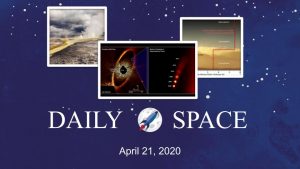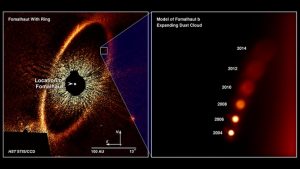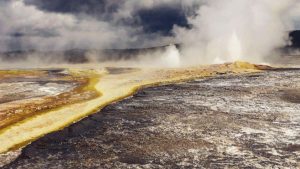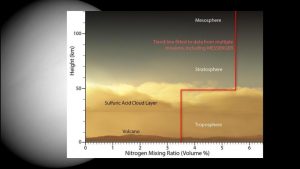
Hubble Observes Aftermath of Massive Collision, offering insight into the nature of exoplanet Fomalhaut b, new research may help solve the question of whether our atmosphere was formed by gases naturally emitted by the Earth’s interior or was added later, and data collected by MESSENGER above Venus’ surface, demonstrates the planet’s atmosphere isn’t uniformly mixed.
Links
Hubble Observes Aftermath of Massive Collision
- Astronomers Discover Planet that Never Was (U of Arizona)
- The Hubble Space Telescope offers insight into the nature of exoplanet Fomalhaut b (Hubble Space Telescope)
New research may help solve the question of whether our atmosphere was formed by gases naturally emitted by the Earth’s interior or was added later
Data collected by MESSENGER above Venus’ surface, demonstrates the planet’s atmosphere isn’t uniformly mixed.
Transcript
This is the Daily Space for today, Tuesday, April 21, 2020. I am your host Dr. Pamela Gay, and I am here to put science in your brain.
Today’s news is a bit gassy. We’re not quite sure how this happened. While I knew a whole lot of science focused on the parts of the universe that aren’t solid or plasma, I hadn’t expected the solid stuff to become gassy stuff.

As described in no less than 3 press releases and 1 conference proceeding, the planet we thought we’d found around the star Fomalhaut has gone away, dissipating into a cloud of gas and dust. First discovered in 2004, the not-still-a-planet Fomalhaut b was directly imaged by the Hubble Space Telescope as a small, coherent, planet looking thing. It was observed repeatedly, and continued to shine bright in 2006, but starting in 2008, this world seemed to be expanding – and expansion is not something we expect of our planets. By the 2014 observations, this world was gone.
The observing team believes that shortly before its discovery images were taken in 2004, this world had a bad collision. According to the spacetelescope.org press release, this object always looked a little bit off. Here is how they describe it, “The object was unusually bright in visible light, but did not have any detectable infrared heat signature. Astronomers proposed that the added brightness came from a huge shell or ring of dust encircling the object that may have been collision-related.” While the object labeled “planet” could be explained with a certain amount of hand-waving, what was harder to explain was its path – which wasn’t an elliptical orbit so much as a trajectory of escape.
Now… several years of observing later, scientists have realized it wasn’t so much a cloud around a planet as just a cloud. While it may have been vaguely planet-sized to begin with, over time this cloud has expanded to be about the size of the Earth’s orbit, and at this point, the light it reflects is so spread out that it isn’t detectable even to the Hubble Space Telescope.
Remarkably, the objects that collided to create this debris cloud didn’t have to be that big. The star it orbited, Fomalhaut, is about 25 light years away and surrounded by a vast ring of icy debris. It’s believed the colliding objects may have been icy bodies about 200km across. The ices would have largely gone to gas from the energy of the collision, transforming two solid worlds into a cloud of expanding gas and dust on an escape path out of its solar system.

CREDIT: Peter Barry/Woods Hole Oceanographic Institute
The way so many elements like to go to gas when heated the slightest bit is a bit problematic. Our own Earth has an atmosphere made of these kinds of materials – Nitrogen, Carbon Dioxide, Oxygen – And we know that early on in our planet’s history, our world was so hot that all these elements should have gone away. Over the years, we’ve figured out how oxygen and carbon dioxide probably came back to Earth on comets and asteroids . Nitrogen had two origins – dredged up or collided into Earth – but sorting which option has proven hard. In this new work, led by Edward Young, scientists collected gases from volcanoes,very carefully, and looked at the compositions. They found that the gases coming out of volcanoes were consistent with atmospheric gases and it appears that nitrogen was brought back to Earth and then added into the planet so that it could come back out later. Essentially, our world is a giant nitrogen recycler.
So – that nitrogen that makes up 78% of the gas we breathe is nitrogen from impactors not nitrogen from the primordial Earth.

CREDIT: Johns Hopkins APL
Understanding the interplay of gases in our atmosphere is hard, even here on Earth where we can measure pretty much anything we want. For world’s like Mars, we at least have rovers in multiple places to sample the air around them. With worlds like Venus – well, Venus likes to destroy things, so most of what we know has come from passing spacecraft, and even those are very rare. One way we can essentially get free data is to study Venus with spacecraft on their way to other worlds or to the Sun. One such mission was the MESSENGER mission, which visited Mercury several years ago. On its way there it used Venus’s gravity to adjust its orbit, and during a June 2007 flyby it tested its instruments by studying the great beige world of death. As reported in the journal Nature Astronomy, they discovered that the nitrogen concentration in Venus’s atmosphere increased with altitude. Prior to this measurement, it had been assumed that the nitrogen was constant with altitude. This means we’re going to have to rethink chemical models of the atmosphere and how those deadly molecules that define Venus’s cloud cover may change as a function of altitude. This discovery is going into justifying the need for different proposed spacecraft both here in the US and in Russia.
What is particularly frustrating about this discovery is no one wanted to fund using MESSENGER’s test data for science. While the data was taken in 2007, it was only possible for team members to get time to do this research recently due to happenstance. Actual proposals were denied. This is a reminder that often people can’t work on projects as volunteers, and science funding is super limited and even the best data can’t always be processed due simply to a lack of money. We’re glad that this team found a way, and we applaud their determination.
And this rounds out our show for today.
<———————>
As part of helping keep us all occupied in these really weird times, we’re going to be hosting a lot of additional content on our Twitch channel, and we want to remind you that CosmoQuest has an active community on Discord where you can talk science, volunteer for various projects, and even find other people to join you in playing some online games. You can find links to everything that is going on at CosmoQuest.org.
Thank you all for listening. Today’s script was written by Pamela Gay, and the Daily Space is produced by Susie Murph. The Daily Space is a product of the Planetary Science Institute, a 501(c)3 non profit dedicated to exploring our Solar System and beyond. We are here thanks to the generous contributions of people like you. The best way you can support us is through Patreon.com/cosmoquestx Like us? Please share us! You never know whose life you can change by adding a daily dose of science.


 We record most shows live, on Twitch. Follow us today to get alerts when we go live.
We record most shows live, on Twitch. Follow us today to get alerts when we go live.